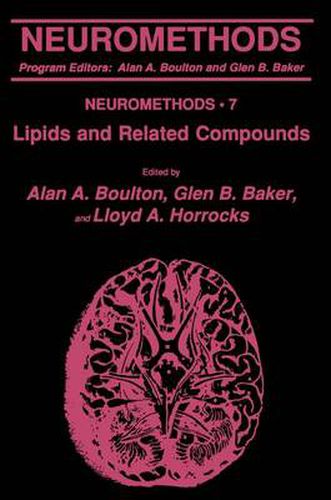Readings Newsletter
Become a Readings Member to make your shopping experience even easier.
Sign in or sign up for free!
You’re not far away from qualifying for FREE standard shipping within Australia
You’ve qualified for FREE standard shipping within Australia
The cart is loading…






This title is printed to order. This book may have been self-published. If so, we cannot guarantee the quality of the content. In the main most books will have gone through the editing process however some may not. We therefore suggest that you be aware of this before ordering this book. If in doubt check either the author or publisher’s details as we are unable to accept any returns unless they are faulty. Please contact us if you have any questions.
Lipids m the nervous system are major components of the m- branes. The presence of glycolipids in high concentrations is unique for the nervous system. Recent discoverres of the functronal and pathological importance of lipids such as diacylglycerols, polyphosphoinositides, prostaglandins, leukotrienes, docosahexaenoic acid, platelet activating factor, and gangliosides have markedly increased the number of publications on nervous system lipids. Many new methods have been developed. Thus, there IS a need for this volume that is dedicated to that methodo- gy. This volume places all of the methods for lipids into perspective with recommendations concerning the selection of a method for a specific purpose. Lloyd A. Horrocks vii Contents …Preface to the Series vi Preface…*…xix List of Contributors Lipid Extraction Norman S. Radin 1 1. Introduction …5 2. Properties of Solvents 2.1. Ethers …6 8 2.2. Alcohols …9 2.3. Halocarbons …9 2.4. Hydrocarbons …2.5. Miscellaneous Solvents …10 …10 3. Storage of Lipid Extracts 14 4. Homogenizers …15 5. Separating the Extract from the Tissue Residue 15 5.1. Use of Filtration …16 5.2. Centrifugation …17 6. Removing Nonlipids from Lipid Extracts 6.1. Removal of Nonlipids by Evaporation and Reextraction …17 …17 6.2. Prewashing the Tissue Sample. 6.3. Removal of Nonlipids by Precipitating the Lipids with the Proteins …18 …19 6.4. Liquid/Liquid Partitioning …19 6.5. Removal of Nonlipids by Dialysis 6.6. Separation from Nonlipids by Changing a 21 Partition Constant …
$9.00 standard shipping within Australia
FREE standard shipping within Australia for orders over $100.00
Express & International shipping calculated at checkout
This title is printed to order. This book may have been self-published. If so, we cannot guarantee the quality of the content. In the main most books will have gone through the editing process however some may not. We therefore suggest that you be aware of this before ordering this book. If in doubt check either the author or publisher’s details as we are unable to accept any returns unless they are faulty. Please contact us if you have any questions.
Lipids m the nervous system are major components of the m- branes. The presence of glycolipids in high concentrations is unique for the nervous system. Recent discoverres of the functronal and pathological importance of lipids such as diacylglycerols, polyphosphoinositides, prostaglandins, leukotrienes, docosahexaenoic acid, platelet activating factor, and gangliosides have markedly increased the number of publications on nervous system lipids. Many new methods have been developed. Thus, there IS a need for this volume that is dedicated to that methodo- gy. This volume places all of the methods for lipids into perspective with recommendations concerning the selection of a method for a specific purpose. Lloyd A. Horrocks vii Contents …Preface to the Series vi Preface…*…xix List of Contributors Lipid Extraction Norman S. Radin 1 1. Introduction …5 2. Properties of Solvents 2.1. Ethers …6 8 2.2. Alcohols …9 2.3. Halocarbons …9 2.4. Hydrocarbons …2.5. Miscellaneous Solvents …10 …10 3. Storage of Lipid Extracts 14 4. Homogenizers …15 5. Separating the Extract from the Tissue Residue 15 5.1. Use of Filtration …16 5.2. Centrifugation …17 6. Removing Nonlipids from Lipid Extracts 6.1. Removal of Nonlipids by Evaporation and Reextraction …17 …17 6.2. Prewashing the Tissue Sample. 6.3. Removal of Nonlipids by Precipitating the Lipids with the Proteins …18 …19 6.4. Liquid/Liquid Partitioning …19 6.5. Removal of Nonlipids by Dialysis 6.6. Separation from Nonlipids by Changing a 21 Partition Constant …